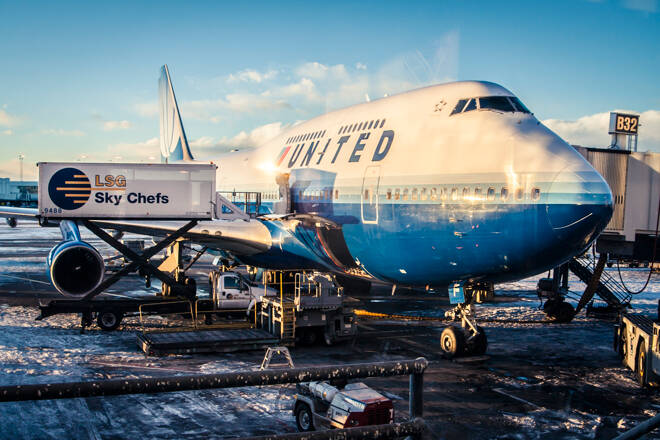Advertisement
Advertisement
United Airlines Shares Slump on Deep Quarterly Loss; Lost $7.1 Billion in 2020
By:
United Airlines reported worse-than-expected earnings in the fourth quarter with net loss ballooning to $1.9 billion and to $7.1 billion for the full-year 2020 as the COVID-19 pandemic restrictions hammered air travel demand, sending its shares down about 3% in extended trading on Wednesday.
United Airlines reported worse-than-expected earnings in the fourth quarter with net loss ballooning to $1.9 billion and to $7.1 billion for the full-year 2020 as the COVID-19 pandemic restrictions hammered air travel demand, sending its shares down about 3% in extended trading on Wednesday.
Chicago, Illinois-based airline reported fourth-quarter adjusted net loss of $2.1 billion, or a loss of $7 per share. That missed Wall Street’s estimates for a loss of $6.56 per share. The airlines’ reported loss of $7.7 billion for the full-year 2020 and total operating revenue declined 69% to $3.4 billion from the same quarter in 2019.
“Domestic remained the relative source of strength for the airline, as revenues fell 72% compared to international down 83%. The one source of relative strength on the international side was Latin America, which saw revenues decline by just 65% y-o-y as leisure demand to the region has remained strong. Cargo revenue was another source of strength, increasing 77% y-o-y, with other operating revenue declining by 31% y-o-y,” wrote Sheila Kahyaoglu, equity analyst at Jefferies.
The airline which operates a large domestic and international route network spanning cities large and small across the United States and all six continents said over the last three quarters, the company has identified $1.4 billion of annual cost savings and has a path to achieve at least $2.0 billion in structural reductions moving forward.
United Airlines forecasts the first quarter 2021 total operating revenue to be down 65-70% versus the first quarter of 2019. Accelerated distribution of the COVID-19 vaccine may lead to faster improvement, however, the company is not including this potential improvement in its first-quarter 2021 revenue outlook. The airline forecast first-quarter 2021 capacity to be down at least 51%.
United Airlines shares slumped about 3% to $43.97 in extended trading on Wednesday; the stock plunged 50% in 2020.
Analyst Comments
“United reported 4Q20 adjusted EPS slightly below our and Street expectations. Near term revenue trends are slightly worse than expected, but likely not a major focus for investors. Management targeted +$2 Bn in annual costs savings that should allow them to exceed2019 EBITDA margins by 2023. Many will look for comments on summer bookings as a snapback in 2H21 travel is expected,” said Helane Becker, equity analyst at Cowen and company.
“Trading activity will likely hinge on management comments about summer bookings and if they’ve seen any increased activity to support the idea of pent-up demand. The idea of a strong 2H21 will be dictated by vaccine distribution, something the Biden administration should push aggressively early in his administration.”
United Airlines Stock Price Forecast
Thirteen analysts who offered stock ratings for United Airlines in the last three months forecast the average price in 12 months at $48.91 with a high forecast of $62.00 and a low forecast of $32.00.
The average price target represents an 8.26% increase from the last price of $45.18. From those 13 analysts, four rated “Buy”, five rated “Hold” and four rated “Sell”, according to Tipranks.
Morgan Stanley gave a base target price of $37 with a high of $79 under a bull scenario and $21 under the worst-case scenario. The firm currently has an “Underweight” rating on the airline holding company’s stock.
“Why Underweight? We believe United Airlines (UAL) has the most challenged network of any airline in our coverage based on our path for a COVID-19 recovery and a levered balance sheet, which could limit rebound opportunities. In addition, UAL’s new CEO Scott Kirby (former COO) is very well regarded by investors but investors may wait to see evidence that UAL is indeed focused on cost improvement rather than aggressive growth (at the cost of PRASM) before giving the stock credit,” said Ravi Shanker, equity analyst at Morgan Stanley.
Several other analysts have also recently commented on the stock. Stifel raised the target price to $47 from $33. Cowen and company upped to outperform from market perform, raising the price objective to $53 from $34. BNP Paribas issued an “underperform” rating and a $32 target price for the company. Citigroup reduced their price target to $43 from $47 and set a “buy” rating.
In addition, Zacks Investment Research downgraded to a “sell” rating from a “hold” and set a $38 price target. Jefferies Financial Group issued a “hold” rating and a $45 price target. At last, Exane BNP Paribas issued an “underperform” rating and a $32 price target for the company.
Check out FX Empire’s earnings calendar
About the Author
Vivek Kumarauthor
Vivek has over five years of experience in working for the financial market as a strategist and economist.
Advertisement
